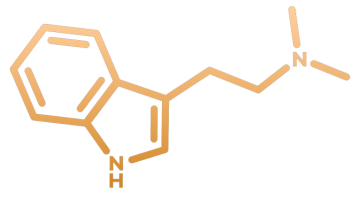DMT during psychedelic-assisted therapy (PAT)
DMT is a powerful hallucinogenic substance that occurs naturally in many plants and animals and is being investigated for use in DMT therapy. It has been traditionally used in shamanic rituals such as bee ayahuasca and has recently gained popularity as a recreational drug. Research suggests that DMT may have therapeutic potential for treating several mental health conditions, including depression, anxiety and trauma-related conditions.
DMT is very similar in effect to the most researched psychedelic psilocybin. Due to this similarity, approximately the same effects are expected as the studies on psilocybin.
Current studies on DMT as a therapeutic tool are increasing, but not as much as the safer and expectedly better-working psilocybin.
Therapeutic effects in the treatment of depression: Some clinical trials were conducted to investigate the potential therapeutic benefits of DMT in the treatment of depressive disorders. These studies focused on the effects of DMT on participants' mood, well-being, and overall mental health.
Neurological effects: Some researchers have studied the effects of DMT on brain activity using techniques such as functional magnetic resonance imaging (fMRI) and electroencephalography (EEG). These studies aimed to understand the neurological mechanisms behind DMT's effects on perception, consciousness and other cognitive processes.
Spiritual experiences: Studies were also underway to investigate the role of DMT in spiritual experiences. These studies aimed to understand the effects of DMT on the sense of connection, transcendence and mystical experiences.
The DMT trip
DMT has a very short duration of action and often lasts only a few minutes. DMT does not work when taken orally without MAOi. This is because the molecule is broken down in the gastrointestinal tract by an enzyme called monoamine oxidase (MAO) before it reaches the brain. To avoid this, DMT can only be taken via a smoking or vaping method. After just a minute, the effects begin to intensify.
The DMT journey is often described as intense and very visual with geometric shapes playing a major role. The effects vary from person to person but may include visual hallucinations, intense emotions and loss of the sense of time and space. All in all, a DMT trip only lasts an hour while the peak effects are short.

DMT therapy is still illegal
DMT therapy is not yet possible. DMT, also known as dimethyltryptamine, is classified as a controlled substance in several countries. It is on the Controlled Substances List of the United States, Canada, the United Kingdom, and several other countries. In the Netherlands it has been classified as a hard drug since 1999, making its possession and sale illegal under the Opium Act. Our expectation is that if the many ongoing studies show many good results, DMT will eventually be legalized for various types of therapy.
Legal Alternatives to DMT
Currently, there are no other substances that act as quickly as DMT and provide the same effects. Psilocybin can produce approximately the same visual effects provided the dosage is high enough. Psilocybin does not work via a vaporizer, but it does work orally. The difference between vaping DMT and taking psilocybin orally is mainly in the long duration of the psilocybin session, which lasts about 6 hours. Some people suggest that 5-MeO-DMT can be an alternative, but this substance does not produce any visual effects.
DMT

Psilocybin

Psilocybin therapy as the best alternative
Most customers looking for DMT therapy often choose psilocybin as an alternative because psilocybin has often proven to be effective for complaints for which these people are looking for a remedy. On the page below we have described what psilocybin helps and how psilocybin works as a therapeutic aid.
